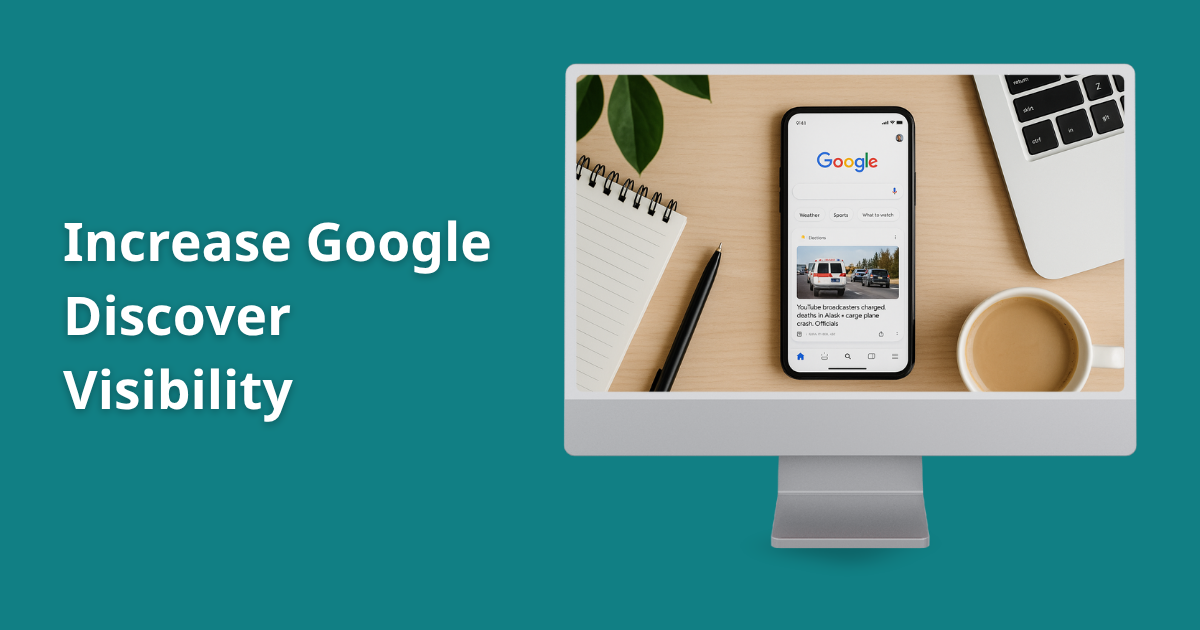Key Takeaways
- Help first, optimize second. Focus on being genuinely useful and trustworthy to increase Google Discover visibility.
- Mobile and technical excellence are essential. Speed, clarity, and responsive design matter.
- Visuals and engagement matter. Headlines, images, and push notifications can make your content stand out.
- Stay timely. Mix evergreen advice with fresh takes on current topics.
- Learn and adjust. Monitor your performance and keep improving.
If you want your content to show up more often in Google Discover, focus on helping real people, not just pleasing algorithms.
That’s the honest secret to increasing Google Discover visibility: create meaningful content, make it accessible, and put genuine value first.
In this blog, I’ll break down what really matters for Google Discover, share practical tips, and help you reach more readers. There’s no need to over-optimize or lose your voice along the way.
What is Google Discover and Why Does Visibility Matter?
Google Discover is a feed of content that appears on Google’s mobile app and homepage. The feed is tailored to each user’s interests. It’s not just about what people are searching for at that moment. It’s about what Google thinks they’ll find interesting, helpful, or inspiring.
When your content appears in Google Discover, you’re reaching people who may have never searched for your topic. That’s powerful.
But here’s the challenge for that: Discover works differently than classic search. It’s driven by relevance, engagement, expertise, and how well your content connects with people in real life. So, how do you increase your Google Discover visibility?
How Do You Increase Google Discover Visibility?
Answer the main question. The most effective way to increase Google Discover visibility is to create content that feels genuine, helpful, and relevant to your ideal reader.
Then, present it in a way that’s easy to enjoy, especially on mobile. You don’t have to chase trends or stuff keywords. You just have to serve real people, honestly and consistently.
1. Build Trust with E-E-A-T (Experience, Expertise, Authoritativeness, Trust)
Google wants to show content that people can trust, especially in Google Discover. That means sharing real stories, lessons learned, and honest insights. When you write from experience, whether it’s a case study, a personal story, or advice from your own journey, you build credibility.
Show your experience. If you’re a small business owner, share what you’ve learned running your business. If you’re a content creator, talk about your process and the results you’ve seen.
Demonstrate expertise and authority. Link to sources you trust. Be transparent about what you know. It’s okay to mention what you’re still learning, too.
Build trust. Avoid clickbait or exaggeration. Stay true to your word. Readers and Google will notice.
2. Make Your Content Engaging and Easy to Enjoy
Engagement metrics are important signals for Google Discover. These include how many people click your article, how long they spend reading, and whether they come back for more. If your content feels natural, conversational, and relatable, people will stick around. Google will pay attention.
Use headlines that speak to your audience. Avoid misleading titles. A headline that promises what your article delivers works best for increasing Discover engagement metrics.
Add meaningful visuals. Eye-catching images or graphics can make your post stand out in a scroll-heavy feed. Make sure every visual adds to the story you’re telling.
Write with warmth and clarity. Imagine explaining your topic to a friend. Use words and examples that make sense. Avoid jargon whenever possible.
3. Prioritize Mobile Optimization and Technical Excellence
Google Discover is primarily mobile. That means your site needs to load fast, look great on any screen, and feel easy to use.
Test your site on different devices. Make sure buttons, images, and text all look right, especially on smaller screens.
Speed matters. Compress images. Streamline your code. Use tools like Google’s PageSpeed Insights to catch slowdowns.
Structure your site for easy navigation. Logical menus, helpful internal links and clean design help Google and readers find what they need.
4. Stay Fresh and Relevant
Google Discover loves content that feels new and timely. That doesn’t mean you have to chase every trend. It does mean you should regularly update your posts, add your voice to ongoing conversations, and write about what matters now.
Use Google Trends or autocomplete. See what people are searching for in your niche. This helps you create content that feels fresh and relevant.
Update older posts. Refresh stats. Add new insights. Keep your content current.
Mix evergreen with timely content. Some topics never go out of style. But adding your thoughts on recent developments can help your blog surface in Discover feeds.
5. Use Web Stories and Hybrid Push Notifications
Google Web Stories are visually rich and tappable. They can help you reach more Discover users. They’re great for quick tips, recipes, or inspiring mini-guides. Hybrid push notifications, which blend editorial updates and gentle reminders, can also spark early engagement and help Google see your content as valuable.
Experiment with Google Web Stories. Turn a popular blog post into a visual story. Or use stories to highlight quick, helpful tips.
Send hybrid push notifications. Remind subscribers when you publish something new. The goal isn’t to spam, but to invite your audience back for more.
6. Track Your Progress and Learn as You Go
Check the Discover tab in Google Search Console. See which posts are appearing, how many people are seeing them, and what’s getting clicks. Use this data to refine your content and build on what’s working.
Conclusion
At the end of the day, increasing Google Discover visibility isn’t about chasing numbers or gaming the system. It’s about reaching the people who need your message most, right when they’re open to hearing it. Write with empathy. Stay curious.
Always look for ways to help. When you do, both Google Discover and your readers will take notice.
